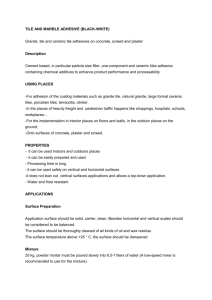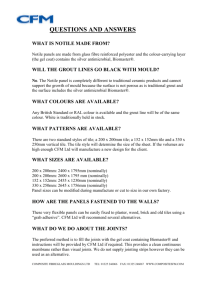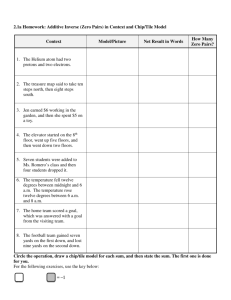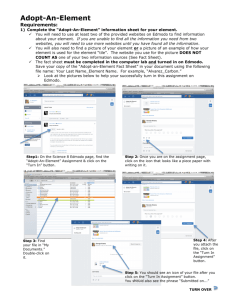Ceramic Tiling - laschools.org
advertisement
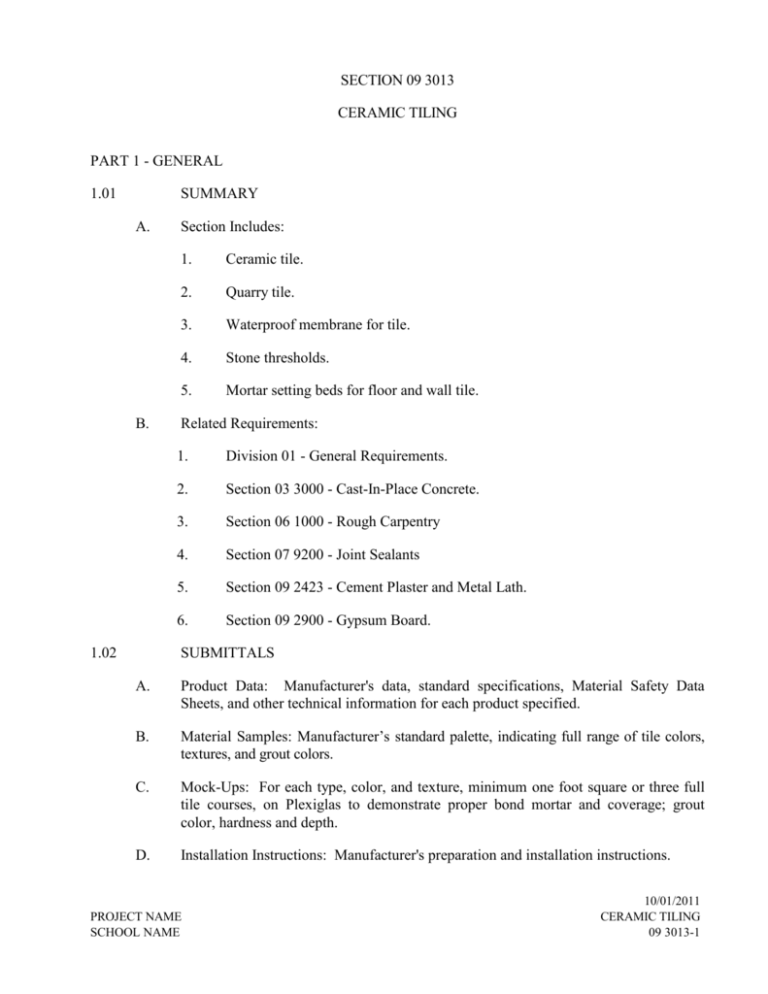
SECTION 09 3013 CERAMIC TILING PART 1 - GENERAL 1.01 SUMMARY A. B. 1.02 Section Includes: 1. Ceramic tile. 2. Quarry tile. 3. Waterproof membrane for tile. 4. Stone thresholds. 5. Mortar setting beds for floor and wall tile. Related Requirements: 1. Division 01 - General Requirements. 2. Section 03 3000 - Cast-In-Place Concrete. 3. Section 06 1000 - Rough Carpentry 4. Section 07 9200 - Joint Sealants 5. Section 09 2423 - Cement Plaster and Metal Lath. 6. Section 09 2900 - Gypsum Board. SUBMITTALS A. Product Data: Manufacturer's data, standard specifications, Material Safety Data Sheets, and other technical information for each product specified. B. Material Samples: Manufacturer’s standard palette, indicating full range of tile colors, textures, and grout colors. C. Mock-Ups: For each type, color, and texture, minimum one foot square or three full tile courses, on Plexiglas to demonstrate proper bond mortar and coverage; grout color, hardness and depth. D. Installation Instructions: Manufacturer's preparation and installation instructions. PROJECT NAME SCHOOL NAME 10/01/2011 CERAMIC TILING 09 3013-1 E. 1.03 Product Certificates: Signed by manufacturer certifying that products furnished comply with requirements of this Specification. QUALITY ASSURANCE A. B. Comply with applicable parts of the following codes or standards as a minimum requirement: 1. ANSI A108, American National Standard Specifications for the Installation of Ceramic Tile. 2. ANSI A118, American National Standard Specifications for Ceramic Tile Installation Materials. 3. ANSI A136.1, Standard Specifications for Ceramic Tile. 4. ASTM A185 - Standard Specification for Steel Welded Wire Reinforcement, Plain, for Concrete. 5. ASTM C185 - Standard Test Method for Air Content of Hydraulic Cement Mortar. 6. ASTM C144 - Standard Specification for Aggregate for Masonry Mortar. 7. ASTM C150 - Standard Specification for Portland Cement. 8. ASTM C241 - Standard Test Method for Abrasion Resistance of Stone Subjected to Foot Traffic. 9. ASTM C206 - Standard Specification for Finishing Hydrated Lime 10. ASTM C503 - Standard Specification for Marble Dimension Stone. 11. ASTM C645 - Standard Specification for Nonstructural Steel Framing Members. 12. ASTM D4551 - Standard Specification for Poly (Vinyl Chloride) (PVC) Plastic Flexible Concealed Water-Containment Membrane. 13. Tile Council of North America (TCNA) – Current edition of “Handbook for Ceramic Tile installation”. 14. CHPS Low-Emitting Materials Table: Materials submitted for tile assemblies must bee listed as low emitting on the CHPS website www.CHPS.net. Grade Certificate and Labeling: With each delivery of tile, furnish manufacturer’s “Master Grade Certificate” to the Project Inspector. PROJECT NAME SCHOOL NAME 10/01/2011 CERAMIC TILING 09 3013-2 C. Source of Materials: Provide materials obtained from one source for each type and color of tile, grout, and setting materials. D. Consistent Quality: Products shall be consistent in appearance and physical properties. E. Comply with requirements of California Building Code and ADAAG. F. Qualifications of Tile Manufacturer: Company specializing in ceramic tile, mosaics, pavers, trim units, and thresholds with five years minimum experience. G. Qualification of Installation System Manufacturer: Company specializing in installation systems/ mortars, grouts/ adhesives with ten years minimum experience. H. Qualifications of Installer: Company specializing in installation of ceramic tile, mosaics, pavers, trim units and thresholds with five years experience with installations of similar scope, materials, and design. I. Pre-Construction Meetings: Prior to start of Work of this section and after approval of submittals, schedule an on-site meeting between Contractor, OAR, Project Inspector, and representatives of the material manufacturer and tile installer to review construction conditions and Drawings for conformance with the requirements of this Specification for each substrate. 1.04 DELIVERY, STORAGE AND HANDLING A. Deliver tile and other materials in sealed containers, with manufacturer's labels intact. B. Keep all materials clean and dry. 1.05 MAINTENANCE A. 1.06 Extra Materials: Provide a minimum of five percent of each type and color as the installed tile, in manufacturers’ cartons and labeled. WARRANTY A. Manufacturer shall provide a five year material warranty. B. Installer shall provide a five year fabrication and installation warranty. C. For waterproofing, manufacturer shall provide a 10 year material warranty for waterproofing installation, tile setting, and grouting materials. PART 2 - PRODUCTS 2.01 PROJECT NAME SCHOOL NAME MANUFACTURERS 10/01/2011 CERAMIC TILING 09 3013-3 A. B. 2.02 Tile: To establish quality, Specification is based on ANSI A137.1 Standard Grade. Equivalent tile products from the following manufacturers may be provided: 1. Dal-Tile Corporation. 2. American Olean Company. 3. Florida Tile, Inc. 4. Equal. Installation Materials: To establish quality for setting and waterproofing materials, Specification is based on ANSI A137.1. Products and methods of the following manufacturers may be provided: 1. Laticrete International, Inc. 2. Custom Building Products. 3. Mapei. 4. Equal. MATERIALS A. Colors, Textures, and Patterns: Tile shall be from manufacturer’s standard product line. 90 percent shall be from “price group 2”, and “10 percent from price group 3”, unless indicated otherwise. Tile trim and accessories shall match adjoining tile. Grout color shall match tile unless otherwise indicated. B. Tile sizes: Tile sizes specified are modular dimensions unless otherwise indicated. C. Mortar Sand: ASTM C144. D. Portland Cement: ASTM C 50, Type I or II. E. Hydrated Lime: ASTM C207, Type S; or ASTM C206 Type S F. Portland Cement Mortar: ANSI 118.1 G. Portland Cement Mortar Bed: Sand-cement mortar mix gauged with Laticrete Acrylic Admix or Custom Building Products Thin-Set Mortar Admix. H. Portland Cement Mortar Bed for Shower Areas: Laticrete 226 Thick Bed Mortar Mix Gauged with Laticrete 3701 Mortar and Grout Admix or on site mix per ANSI A108.1A with Custom Building Products Thin-Set Mortar Admix. PROJECT NAME SCHOOL NAME 10/01/2011 CERAMIC TILING 09 3013-4 I. Latex Portland Cement Bond Mortar: Laticrete 317 Floor & Wall Thinset gauged with Laticrete 3701 Admix, or Custom Building Products Master Blend mixed with Thin-Set Mortar Admix. J. Waterproof Membrane: Cold-applied, single component liquid with embedded reinforcing fabric where recommended by manufacturer: Laticrete Hydro Ban Waterproof Membrane or Custom Building Products Red Guard Waterproof Membrane. K. Reinforcing Wire Fabric: 2-inch by 2-inch, 16 by 16 gage, galvanized electrically welded wire reinforcing, per ASTM A 185. L. Latex Portland Cement Grout: Laticrete Sanded Grout (1500 Series), Custom Polyblend Sanded Grout or Laticrete Unsanded Grout 1600 Series (for joints smaller than 1/8”), Custom Polyblend Unsanded Grout. M. Epoxy Grout for Quarry Tile: Laticrete Spectralock Pro Epoxy Grout for Floors and Walls or Custom 100 percent Solids Epoxy Grout. N. Cleavage Membrane and Wall Backing Paper: Cleavage membrane shall be 15-pound asphalt-saturated felt manufactured according to ASTM D226 Standard Specification for Asphalt-Saturated Organic Felt Used in Roofing and Waterproofing O. Separation Material (for all sealed joints including perimeters and quarry-tile fields of floor mortar beds): Quality Foam, QF 200 white, 3/8 inch wide by 5-inch high. P. Backer Rod for sealants (for ceramic mosaic fields): Polyethylene foam, closed-cell, flexible and compressible, 3/16 inch diameter. Q. Cleaner and Sealer: R. 1. Cleaner and sealer shall be from one manufacturer, acceptable to tile and grout manufacturers. To establish quality, the Specification is based on Aqua Mix Inc. Equivalent products from Miracle Sealants Co., Watco Tile and Brick, or equal may be provided. 2. Cleaner: Aqua Mix Concentrated Tile Cleaner, neutral phosphate-free cleaner, or Custom Building Products Tile Lab Concentrated Tile and Stone Cleaner. 3. Sealer: Aqua Mix Penetrating Sealer, fungus- and bacteria-resistant, stainresistant, and slip-resistant as specified for tile, Custom Building Products Tile Lab Surface Gard, or equal. Sealants: 1. PROJECT NAME SCHOOL NAME Sealant and primer shall be from one manufacturer, acceptable to tile and grout manufacturers. See Section 07 9200 - Joint Sealants. 10/01/2011 CERAMIC TILING 09 3013-5 2.03 2. Ceramic Mosaic Tile: One-Part, Mildew-Resistant Silicone Sealant: ASTM C 920; Type S; Grade NS; Class 25; Uses NT, G, A, and, as applicable to nonporous joint substrates indicated, O; formulated with fungicide, intended for sealing interior ceramic tile joints and other nonporous substrates that are subject to in-service exposures of high humidity and extreme temperatures. 3. Quarry Tile: Multipart, Pourable Urethane Sealant for Use T: ASTM C 920; Type M; Grade P; Class 25; Uses T, M, A, and, as applicable to joint substrates indicated, O. TILE A. B. C. D. Unglazed Ceramic Mosaic Floor Tile: 1. Size: 1 inch by 1 inch or as indicated. 2. Colors and patterns as selected by Architect from price groups specified. 3. Slip Resistance: Resistant to slipping appropriate to the installed conditions of use, as required by the California Building Code and ADAAG. a. As a minimum, the coefficient of friction as measured by ASTM C1028 shall be 0.6 except ramps shall be 0.8. b. For tile in shower and locker areas, incorporate grit into tile to increase slip resistance. Glazed Wall Tile: 1. Size: 4-1/4 inch by 4-1/4 inch face dimensions by 5/16 inch thick (ceramic mosaic tile may also be used on walls). 2. Colors and patterns as selected by Architect from price groups specified. Unglazed Paver Tile: 1. Porcelain, flat tile. 2. Size: 12 inch by 12 inch, or as shown. 3. Colors and patterns as selected by Architect from price groups specified. 4. Slip Resistance: Resistant to slipping appropriate to the installed conditions of use, as required by the California Building Code and ADAAG. As a minimum, the coefficient of friction as measured by ASTM C1028 shall be 0.6 except ramps shall be 0.8. Trim: PROJECT NAME SCHOOL NAME 10/01/2011 CERAMIC TILING 09 3013-6 E. F. 1. Integral bullnose at external corners. 2. Provide bullnose where tile projects from jamb. 3. Mosaic tile base with wall tile above: A3401. 4. Mosaic tile base without wall tile above: S3619T (6-inch high sanitary coved base). 5. Bullnose at wainscot: A4200 and A4402. Quarry Tile: 1. Size: 6-inch by 6-inch by 1/2 inch, square edge. 2. Slip Resistance: The coefficient of friction shall be 0.6 except for ramps, which shall be 0.8. when tested in “wet conditions” 3. Kitchen Floor Color: Blaze Flash (red). 4. Non-Kitchen Floor Colors: standard colors. 5. Base: Trim shape Q 3565, 6-inch by 5-inch by 1/2 inch cove base, round top with integral bull nose or cove forming corners, and related trim pieces. As selected by Architect from manufacturer’s Stone Thresholds: 1. Exterior installation: Marble thresholds with minimum abrasive hardness value of 10 tested in accordance with ASTM C241. 2. White honed marble complying with Marble Institute of America Group “A,” unless other color indicated. 3. Size and profile shaped to provide transition between tile surfaces and adjoining finished floor surfaces, or as indicated. Width not less than 4 inches. Edges beveled on a slope of no greater than 1:2. Cut to fit door frame profile. PART 3 - EXECUTION 3.01 EXAMINATION AND PREPARATION A. Examine substrates and conditions for compliance with installation requirements. Verify that all penetrations through substrate have been installed. Proceed with Work only after all conditions are in compliance. B. Substrates shall be firm; dry; clean and within flatness tolerances required by relevant ANSI A108 tile installation standards. Prepare surfaces as follows: PROJECT NAME SCHOOL NAME 10/01/2011 CERAMIC TILING 09 3013-7 C. 1. Concrete Floors: Allow concrete floors to cure for 28 days minimum before beginning tile and grout installation. Remove laitance, sand, dust, and loose particles. 2. Plywood Subfloors: Before installing mortar setting bed over plywood subfloors, install cleavage membrane over sub-floor. Anchor firmly in place and lap joints 6 inches minimum. Turn membrane up 6 inches at walls and beneath building felt on walls. Substrates to receive wall tile and base shall be: 1. Scratch coat of cement plaster, as specified in Section 09 2423 - Cement Plaster and Metal Lath (required in student restrooms, showers and locker rooms, and quarry tile bases). 2. Cementitious backing panels, as specified in Section 09 2900 - Gypsum Board. D. Verify that installation of grounds, anchors, recessed frames, electrical and mechanical items of Work, and similar items located in or behind tile has been completed before installing tile. E. Verify that joints and cracks in tile substrates are coordinated with caulked-joint locations; if not coordinated, adjust as required by the Architect. F. Do not install tile until construction in spaces is completed and ambient temperature and humidity conditions are maintained in compliance with referenced standards and manufacturer's written instructions. G. Protect adjacent surfaces during progress of Work of this section. 3.02 TILE INSTALLATION, GENERAL A. Install tile in grid pattern, unless otherwise indicated. Align joints when adjoining tiles on floor, base, walls, and trim are same size. Center the tile fields in both directions for each space or on each wall area. Adjust to minimize tile cutting. Provide uniform joint widths, unless otherwise indicated. B. For tile mounted in sheets: Joints between tile sheets shall be the same width as joints within tile sheets. C. Extend Work into recesses and under or behind equipment and fixtures to form a complete covering without interruptions, unless otherwise indicated. Terminate Work neatly at obstructions, edges, and corners without disrupting pattern or joint alignments. D. Accurately form intersections and returns. Perform cutting and drilling of tile without damaging tile. Carefully grind the cut edges of tile abutting trim, finish, or built-in items. Fit tile closely to electrical outlets, piping, fixtures, and other penetrations so plates, collars, or covers overlap tile. PROJECT NAME SCHOOL NAME 10/01/2011 CERAMIC TILING 09 3013-8 E. Locate joints, directly above joints in concrete substrates, at horizontal and vertical changes in plane, or where indicated during installation of mortar beds. In quarry tile floors, provide at 12 feet on center maximum. Provide 3/8-inch wide foam at joints. Do not saw-cut joints after installing tiles. F. Prepare and clean joints to be sealed. Apply sealants to comply with requirements of Section 07 9200 - Joint Sealants. G. Conform to manufacturers printed instructions, and applicable requirements of ANSI and TCNA Standards. 3.03 TILE INSTALLATION, FLOOR A. Install reinforcing and latex Portland-cement mortar setting bed over cured concrete slab or cleavage membrane on plywood floor. Lap reinforcing at least one full mesh, and support or lift so that it is approximately in the middle of mortar bed. Do not abut against vertical surfaces. Install foam separation material at perimeters and expansion joint locations for caulked joints. B. Mix setting mortar in accordance with ANSI recommendations. C. Once begun, mortar installation must continue until room is completed. Discard any batch not floated and finished within ½ hour of mixing. Firmly compact before screeding. Screed to true plane and pitch as indicated. Slope mortar bed sufficiently that water flows to drain and no puddling will occur. Slope mortar down to floor drains for proper installation of waterproof membrane. After screeding, firmly rub down with steel or wood float. D. Cure mortar bed with a light fog spray of water and cover with 6-mil Visqueen for 72 hours. E. Waterproof Membrane: 1. 2. PROJECT NAME SCHOOL NAME Install waterproof membrane where indicated and in all kitchen, toilet, shower, and locker areas according to TCNA Standards. Extend membrane up wall mortar or backing board as follows: a. 3 inches above top of curb wall. b. 6 inches minimum above floor. c. In shower rooms, install from floor to ceiling. Insure that layers of membrane are fully inserted into clamping ring of floor drain. After membrane installation and before tile setting, install pea gravel around sub drain to prevent blockage of weep holes and place mortar to proper level for setting tile. 10/01/2011 CERAMIC TILING 09 3013-9 3. For tile installations other than slab on grade, before setting tile and after seven days curing, water test membrane by damming drains and doors, filling floor with water to 4-inch minimum depth, and leaving for 24 hours. Correct any leaks and re-test before proceeding. After testing, protect membrane from traffic until tile Work begins. F Thin Set Method: Confirm substrate is completely clean and free of dust. Cut foam at floor perimeters flush with top of mortar bed. Insure that bond coats do not intrude into joints to be sealed. Install tile over properly cured setting bed or waterproof membrane utilizing "thin-set" method with latex portland cement bond mortar, in accordance with manufacturer's printed instructions and ANSI A108.5. G. Minimum coverage of bond mortar shall be 80 percent except 95 percent in shower areas, for quarry tile, and exterior installations. Place tile into fresh mortar press tile to insure full contact. Before setting proceeds, set and remove three tiles or sheets of tiles to confirm specified coverage of bond mortar. If coverage is insufficient, utilize a larger toothed trowel or back butter tiles until proper coverage is provided. H. Install tile on floors with the following joint widths: I. 3.04 1. Ceramic Mosaic Tile: 1/16 to 1/8 inch. 2. Quarry Tile: 1/4 to 3/8 inch. 3. Paver Tile: 3/16 to 3/8 inch. Install base tile for quarry tile floors on a mortar bed, with joints matching floor. TILE INSTALLATION, WALLS A. Install wall mortar beds before floor mortar beds. B. On plaster walls, clean scratch coat surface of loose or foreign materials, fog spray with water, and install brown coat mortar bed over scratch coat to a thickness not less than 3/8 inch and not greater than ¾ inch. Once started, wall mortar installation must continue until wall is completely floated. Discard any batch not floated and finished within ½ hour of mixing. As soon as wall mortar is dried to sufficient hardness, but still plastic, firmly rub with wood float. C. Cover cure with 40-weight Kraft paper for 72 hours minimum. D. Install tile over properly cured setting bed, waterproof membrane, or cementitious backing panels utilizing "thin-set" method with latex portland cement bond mortar, in accordance with manufacturer's printed instructions and ANSI A108.5. Confirm substrate is completely clean and free of dust. Insure that bond coats do not intrude into joints to be caulked. PROJECT NAME SCHOOL NAME 10/01/2011 CERAMIC TILING 09 3013-10 E. Minimum coverage of bond mortar shall be 80 percent except 95 percent in shower areas or exterior installations. Set and test as specified for floors. F. Lay out Work so tiles will be centered on each wall or section of wall in order to minimize tile cuts. Lay out tile wainscots to next full tile beyond dimensions indicated. Spot setting bed with mortared tile, set plumb and true, accurately indicate plane of finished tile surfaces. G. Install tile on walls with following joint widths: 1. Glazed Wall Tile: 1/16 inch. 2. Ceramic Mosaic Tile: 1/16 to 1/8 inch. 3. Quarry Tile: 1/4 to 3/8 inch. 4. Special Large Tile: 3/16 to 3/8 inch. H. Horizontal joints shall be level, vertical joints plumb with surfaces true and plumb, edges of tiles flushed. I. Rub exposed cuts smooth with a fine stone; no cut edge shall be set against a fixture or adjoining surface without a 1/16 inch joint to be caulked. J. Install access doors where required, furnished under another section, in correct location, plumb or level, flush with adjacent construction, and securely fastened to framing. 3.05 GROUTING A. Prior to starting, ensure that all tile surfaces are clean and excessive bond mortar is scraped and vacuumed from joints (approximately 2/3 depth of tile should be open for grouting). Follow manufacturer’s instructions for mixing grout. Once grout Work commences, proceed until complete wall or floor area is finished utilizing one batch of grout. B. Latex portland cement grouting: Dampen tile surface and joints with water using sponge, but leaving no puddles in joints. Force grout into joints using sufficient pressure on rubber float so as to fill joints completely, and scrape excess grout off tile surface with rubber float. Smooth or tool grout to uniform joint finish. Do not over water. C. Curing latex Portland cement grout: Remove final grout haze with clean soft cloth, and cover with 40-weight Kraft paper to cure. Leave paper in place for protection. Cover wall surfaces with 40-weight Kraft paper for 72 hours. D. Epoxy grouting: Do not dampen tile. Follow manufacturer’s instructions for mixing grout. Force grout into joints with sufficient pressure on rubber float so as to fill joints completely, and scrape excess grout off tile surface with rubber float. Smooth or tool grout to uniform joint finish. Do not allow grout to harden on face of tile. PROJECT NAME SCHOOL NAME 10/01/2011 CERAMIC TILING 09 3013-11 E. 3.06 Curing epoxy grout: Do not cover floor, but do not allow foot traffic for 72 hours. Then, if grout is not tacky, cover with 40-weight Kraft paper for protection. CLEANING AND SEALING A. If grout scum is not visible on tile surface after curing, clean tile surface with clear water. Remove and replace cracked, broken or defective Work with proper material. B. If, when curing membrane is removed, grout scum is visible on tile surface, use the following cleaning method: C. 3.06 1. Immediately recover floor with paper or felt and allow to continue curing for a minimum of 14 days; uncover floor and maintain entire tile surface saturated with clean cool water for not less than two hours. 2. Utilize a neutral cleaner acceptable to manufacturers of tile and grout, and follow manufacturer’s instruction. Do not provide generic acid cleaners. 3. Wet tile floors and apply cleaning solution to floor surface, then scrub with a brush. Rinse area several times with clean water to flush solution off floor surface. Apply penetrating sealer in accordance with manufacturer’s instructions utilizing a dense sponge applicator, paint pad, sprayer or brush. Avoid overlapping, puddling, and rundown. Completely wipe surface dry within 3 to 5 minutes using cotton or paper towels; do not allow sealer to dry on tile. After two hours, test surface by applying water droplets to surface. If water is absorbed, apply a second coat. Avoid surface traffic for 24 hours. SEALANTS A. Insure joints to be sealed are free of setting and grouting materials and construction debris. Do not permit any foot traffic on installed sealants for a minimum of 48 hours or protect with hardboard strips. B. Install in accordance with Section 07 9200 - Joint Sealants. 3.07 PROTECTION A. Admit no traffic where tile is installed until mortar and grout has set for a minimum of 72 hours. B. Protect Work of this section until Substantial Completion. 3.08 CLEAN UP A. Remove rubbish, debris, and waste material and legally dispose of off the Project site. PROJECT NAME SCHOOL NAME 10/01/2011 CERAMIC TILING 09 3013-12 END OF SECTION PROJECT NAME SCHOOL NAME 10/01/2011 CERAMIC TILING 09 3013-13
